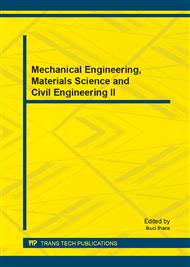[1]
ČSN 73 1208 The design of waterworks concrete structures, ČNI 09/(2010).
Google Scholar
[2]
ČSN EN 1991-1-2 (73 0035) Eurocode 1: Actions on structures - Part 1-2: General actions - Actions on structures exposed to fire. ČNI 08/(2004).
DOI: 10.1002/9783433601570.oth1
Google Scholar
[3]
ČSN EN 1991-1-5 (73 0035) Eurocode 1: Actions on structures - Part 1-5: General actions - Thermal Actions. ČNI 05/(2005).
Google Scholar
[4]
R. Cajka, Temperature effects of large-scale foundation structures (in Czech). Journal Beton a zdivo, No. 1-2/1993, ČBS 1993, pp.57-60 (in Czech).
Google Scholar
[5]
R. Cajka, P. Zidkova: Fire resistance of garage plate-wall prefabricated structure, COST 12 – Final Conference Proceedings, 20th – 22nd January 2005, University of Innsbruck, Austria, ISBN 04 1536 609 7.
DOI: 10.1201/9780203970843.ch32
Google Scholar
[6]
R. Cajka, P. Mateckova: Different Types of Pre-Stressed Hollow Core Panels and their Fire Resistance According to Eurocodes. Journal of Structural Fire Engineering, Volume 1, Number 4, December 2010, Multi-Science Publishing, ISSN 2040-2317.
DOI: 10.1260/2040-2317.1.4.243
Google Scholar
[7]
R. Cajka, P. Mateckova: Study of slab fire resistance according to Eurocode using different computational methods. International Conference Application of Structural Fire Engineering. Prague 29. 4. -30. 4. 2011. ISBN-978-80-01-04798-9.
Google Scholar
[8]
R. Cajka, P. Kucera, P. Mateckova: Numerical analysis of concrete tunnel lining exposed to fire. IABSE Symposium Weimar 2007, ISBN 978-3-85748-116-1.
DOI: 10.2749/weimar.2007.0691
Google Scholar
[9]
R. Cajka, P. Kucera, P. Mateckova: Concrete plane structures loaded by high temperature. The 5th international Conference on Concrete under Severe Conditions of Environment and Loading (CONSEC'07), June 4-6, 2007, Tours, France, ISSN 1626-4704.
Google Scholar
[10]
R. Cajka, P. Mateckova: Influence of humidity on heat-exposure and mechanical response of concrete structure exposed to high temperatures. Fib Symposium Keep Concrete Attractive, 22-25 May 2005, Budapest, Hungary, ISBN 963-420-839-8.
Google Scholar
[11]
R. Cajka, P. Mateckova, Temperature distribution of slide joint in reinforced concrete foundation structures. 17th International Conference on Engineering Mechanics 2011, May 9. -12. 2011, Svratka, Czech Republic, ISBN 978-80-87012-33-8, WOS: 000313492700017.
Google Scholar
[12]
R. Cajka, P. Mateckova, M. Janulikova: Bitumen Sliding Joints for Friction Elimination in Footing Bottom. Applied Mechanics and Materials, Vol. 188 (2012).
DOI: 10.4028/www.scientific.net/amm.188.247
Google Scholar
[13]
P. Kucera, L. Jurencak: Validation of Results of Fire Tests at the Flashover Container. 10th WSEAS International Conference on Heat Transfer, Thermal Engineering and Environment (HTE '12), Istanbul, Turkey, August 21-23, (2012).
Google Scholar
[14]
P. Nevřiva, Simulation of control systems on the digital computer. SNTL Praha, 1975. 136 s.
Google Scholar
[15]
M. Trapeznikova, B. Chetverushkin, N. Churbanova, D. Morozov: Two-Phase Porous Media Flow Simulation on a Hybrid Cluster. I. Lirkov, S. Margenov, and J. Was´niewski (Eds. ): LSSC 2011, LNCS 7116, (c) Springer-Verlag Berlin Heidelberg 2012, p.646–653, (2012).
DOI: 10.1007/978-3-642-29843-1_74
Google Scholar
[16]
R. Cajka, Accuracy of Stress Analysis Using Numerical Integration of Elastic Half-Space (2013).
Google Scholar
[17]
R. Cajka, R. Fojtik, Development of Temperature and Stress during Foundation Slab Concreting of National Supercomputer Centre IT4. Procedia Engineering, Volume 65, 2013, Pages 230-235, ISSN 1877-7058, doi: 10. 1016/j. proeng. 2013. 09. 035.
DOI: 10.1016/j.proeng.2013.09.035
Google Scholar
[18]
R. Cajka, P. Mateckova, Fire Resistance of Ceiling Slab Concreted in Trapezoidal Sheet. Procedia Engineering, Volume 65, 2013, Pages 393-396, ISSN 1877-7058, doi: 10. 1016/j. proeng. 2013. 09. 061.
DOI: 10.1016/j.proeng.2013.09.061
Google Scholar
[19]
R. Cajka, Horizontal Friction Parameters in Soil – Structure Interaction Tasks. Advanced Materials Research, Vol. 818 (2013), pp.197-205, Trans Tech Publications, Switzerland, doi: 10. 4028/www. scientific. net/AMR. 818. 197.
DOI: 10.4028/www.scientific.net/amr.818.197
Google Scholar
[20]
R. Cajka, Analysis of Stress in Half-space using Jacobian of Transformation and Gauss Numerical Integration. Advanced Materials Research, Vol. 818 (2013).
DOI: 10.4028/www.scientific.net/amr.818.178
Google Scholar


